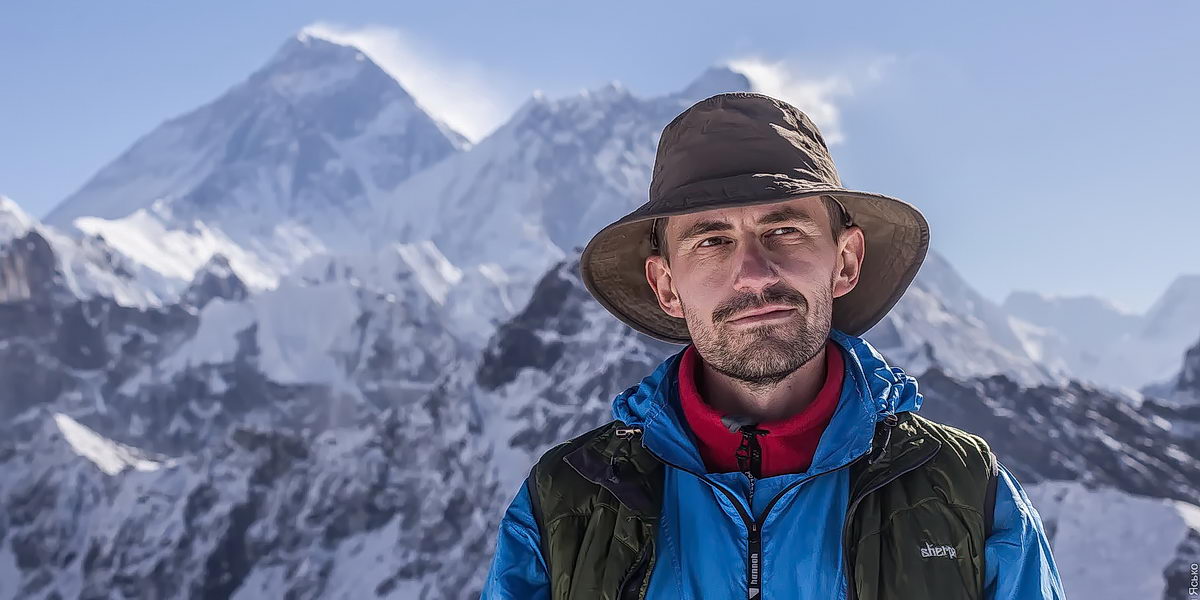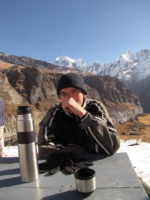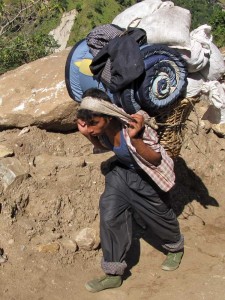 In order to choose the right set of clothes and equipment for a hike, you need to have a very good idea of what awaits you – climate, terrain, loads. Going to the “native” mountains (Crimea, Carpathians) I know all this by 98% and therefore the choice is simple, and the backpack is light – no more than 10 kg. I didn’t know enough about Nepal. Therefore, a lot was taken at random, based only on theoretical reflections and meager information from the network. But already on the third day of the trip, I knew enough to understand that I was carrying 4 kg of “extra” things and equipment. In short, I know more now and would do things differently.
In order to choose the right set of clothes and equipment for a hike, you need to have a very good idea of what awaits you – climate, terrain, loads. Going to the “native” mountains (Crimea, Carpathians) I know all this by 98% and therefore the choice is simple, and the backpack is light – no more than 10 kg. I didn’t know enough about Nepal. Therefore, a lot was taken at random, based only on theoretical reflections and meager information from the network. But already on the third day of the trip, I knew enough to understand that I was carrying 4 kg of “extra” things and equipment. In short, I know more now and would do things differently.
The big picture.
Traditional trekking in Nepal is a little different from our hikes. On popular routes, all overnight stays are made not in tent camps, but in lodges – small hotels that are found in abundance in local villages. Tourists eat in the same hotels. Thus, there is no need to carry a tent, food, burners and pots with you. All this is taken with them only by those who plan to explore the little-visited nooks and crannies of the mountains. Most often these are people who are not the first and not the second time in Nepal. This most likely does not apply to you, so forget about the tent “just in case” and a bag of pasta “in reserve”. All you need is a backpack, sleeping bag and clothes.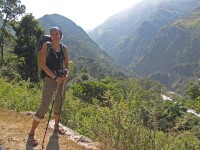
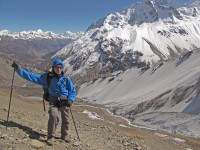 Clothes are chosen according to the weather. As you climb, you will smoothly move from one climate zone to another:
Clothes are chosen according to the weather. As you climb, you will smoothly move from one climate zone to another:
- Moist tropical jungle – +30 during the day, +15 at night, rain is possible
- “Temperate” deciduous forest
- Coniferous forests – day +20, night +5
- Juniper dwarfs
- Alpine meadows
- Stone placers – day +10, night -5, strong winds
- Snow and glaciers.
During the route, the transition from the jungle to the snow and back can occur 2-3 times. But in general, “heat” will be more than “cold”. In a proportion of about three to one.Let me remind you that we went to Nepal in November. In a month we had three cloudy days, one day of rain, which saved us from dust storms.Now that you’re familiar with the weather, let’s start sorting through my junk. For each item, I will indicate the weight, how often it was used, and whether it is advisable to take it in the future. Perhaps we will do this: red I will mark things that are unnecessary, < span style="color: #339966;">green things 100% necessary or highly recommended, black everything else.
Clothes and shoes.
Bestard Alpha Pro NW sneakers.
 Weight 1100 grams. Used 60% of the trip. Sturdy trekking shoes with a thick sole and a stable heel. These are the shoes that I consider ideal for trekking around Annapurna. The trails there are very good, sometimes even lined with stone. Therefore, there is no need to carry heavy and rigid climbing boots on your feet. In autumn, there is snow only above 4500 meters and this is a dense, packed “last year” firn. If you walk along the trails, then contact with the snow of your shoes is practically not threatened. True, at high altitude at night (in case of early exits), it can be cold for your feet in sneakers. So I bought sneakers a size larger than usual to fit thick socks.
Weight 1100 grams. Used 60% of the trip. Sturdy trekking shoes with a thick sole and a stable heel. These are the shoes that I consider ideal for trekking around Annapurna. The trails there are very good, sometimes even lined with stone. Therefore, there is no need to carry heavy and rigid climbing boots on your feet. In autumn, there is snow only above 4500 meters and this is a dense, packed “last year” firn. If you walk along the trails, then contact with the snow of your shoes is practically not threatened. True, at high altitude at night (in case of early exits), it can be cold for your feet in sneakers. So I bought sneakers a size larger than usual to fit thick socks.
Sandals Teva Terra-Fi 2.
 Weight 760 grams. At altitudes up to 2500 meters (and this is 40% of the track and the entire cultural program), it is quite hot during the day and I preferred to walk in sandals. The sneakers were too parky there, primarily due to the presence of Gore-tex in the lining. Those. if your basic footwear is light and breathable enough, then sandals can be “cut”. Well, for me personally, sandals are my favorite shoes, so I cut them last. For example, I did not take them on multi-day radial trips to Lake Tilicho and to the Annapurna base camp. If after the hike we were taken to rafting, I would also go in sandals.
Weight 760 grams. At altitudes up to 2500 meters (and this is 40% of the track and the entire cultural program), it is quite hot during the day and I preferred to walk in sandals. The sneakers were too parky there, primarily due to the presence of Gore-tex in the lining. Those. if your basic footwear is light and breathable enough, then sandals can be “cut”. Well, for me personally, sandals are my favorite shoes, so I cut them last. For example, I did not take them on multi-day radial trips to Lake Tilicho and to the Annapurna base camp. If after the hike we were taken to rafting, I would also go in sandals.
Slippers or flip flops.
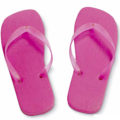 Weight 230 grams. We took one pair of slippers for three. They are only needed to wash in the shower. The floors there are traditionally cold and dirty, so you can’t stand barefoot, and you don’t want to wet your sandals. In Nepalese lodges, there is usually only one shower room with hot water, and that one is tiny. What I mean is that there is practically no chance to take a shower at the same time, so there is no point in carrying more than one pair of slippers. Next time I’ll try to find very thin flip flops weighing no more than 150 grams.
Weight 230 grams. We took one pair of slippers for three. They are only needed to wash in the shower. The floors there are traditionally cold and dirty, so you can’t stand barefoot, and you don’t want to wet your sandals. In Nepalese lodges, there is usually only one shower room with hot water, and that one is tiny. What I mean is that there is practically no chance to take a shower at the same time, so there is no point in carrying more than one pair of slippers. Next time I’ll try to find very thin flip flops weighing no more than 150 grams.
Short shoe covers – gaiters.
 Weight 75 grams. Especially for this trip, I bought short shoe covers from Travel-extreme. They are as much as 200 grams lighter than standard high gaiters (under the knee). At the same time, they do an excellent job with the tasks assigned to them – to prevent snow and dust from getting into sneakers and socks. Our snow was old and packed, and the dust was moistened with rain. Therefore, for the whole trip, I put on minishoe covers only 2 times – on Tilicho Lake (5000m) and on the Thorong La Pass (5416m). In the spring, when there is more snow and it is looser, the demand for shoe covers is higher.
Weight 75 grams. Especially for this trip, I bought short shoe covers from Travel-extreme. They are as much as 200 grams lighter than standard high gaiters (under the knee). At the same time, they do an excellent job with the tasks assigned to them – to prevent snow and dust from getting into sneakers and socks. Our snow was old and packed, and the dust was moistened with rain. Therefore, for the whole trip, I put on minishoe covers only 2 times – on Tilicho Lake (5000m) and on the Thorong La Pass (5416m). In the spring, when there is more snow and it is looser, the demand for shoe covers is higher.
Pants and shorts.
- Travel pants Milo- weight 290 grams.
- Sweatpants – weight 140 grams.
- Shorts – 150 grams
- Thermal underwear (pants) – weight 216 grams.
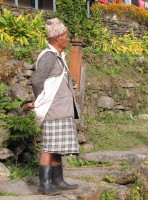 Milo trousers are ordinary thin synthetic trousers, without lining. I went to them 70% of the track and half of the cultural program. Although it was warm in the Kathmandu valley, it was somehow awkward to walk around the temples in shorts. And the evenings in the capital are cool.Spare pants made of very thin synthetics were supposed to be worn while the main trousers were in the wash, or together with the main ones if it was very cold. As a result, they traveled the whole trip in a backpack, and in the end I gave them to a friend to vilify.
Milo trousers are ordinary thin synthetic trousers, without lining. I went to them 70% of the track and half of the cultural program. Although it was warm in the Kathmandu valley, it was somehow awkward to walk around the temples in shorts. And the evenings in the capital are cool.Spare pants made of very thin synthetics were supposed to be worn while the main trousers were in the wash, or together with the main ones if it was very cold. As a result, they traveled the whole trip in a backpack, and in the end I gave them to a friend to vilify.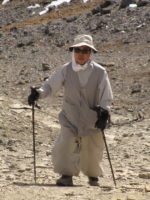 I walked around the tropics in shorts – on the track, in the reserve, in Pokhara. He also used them as swimming trunks in the Tatopani baths.He wore thermal underwear under trousers in the evenings, starting from 3000 meters. He slept in it. During the day, I wore underpants only 2 times when I climbed up to 5000 meters.Obviously, there were too many pants. I want to try to replace the shorts with transformer pants and not take spare pants. Then instead of 4 items and 796 grams, you get 2 items and about 500 grams (thermal underwear + transformer trousers). Or maybe I’ll look for lighter shorts.
I walked around the tropics in shorts – on the track, in the reserve, in Pokhara. He also used them as swimming trunks in the Tatopani baths.He wore thermal underwear under trousers in the evenings, starting from 3000 meters. He slept in it. During the day, I wore underpants only 2 times when I climbed up to 5000 meters.Obviously, there were too many pants. I want to try to replace the shorts with transformer pants and not take spare pants. Then instead of 4 items and 796 grams, you get 2 items and about 500 grams (thermal underwear + transformer trousers). Or maybe I’ll look for lighter shorts.
Linen.
- thermal shorts Rock Front – 105 grams
- cotton briefs, family – 90 grams
One change of linen turned out to be absolutely enough, since there was plenty of time and water for washing throughout the entire trip. At high altitude (read, in cold conditions), I tried to walk more in synthetics so as not to overcool the lower back with wet cotton.
Shirt, t-shirt, fleece.
- shirt Salewa Himba Dry – 235 grams
- thermal T-shirt Grifone – 130 grams
- thermal underwear Comandor (top) – 240 grams
- fleece Campus – 500 grams
I wore a shirt a lot on the track up to a height of 3500 meters and practically did not take it off during the cultural program. It dries very quickly (faster than thermal underwear), which is very convenient both at rest and in the case of washing. In the heat, you can unfasten it on the chest, i.e. increase ventilation without exposing the neck and shoulders to the danger of burning. The sleeves of the shirt, if necessary, are rolled up and fixed with a button-loop. You have already understood that I am delighted with the shirt and consider it almost ideal clothing for a hot climate.I hardly ever wore a T-shirt. Once dressed in Pokhara – after the track. Once I gave it to my wife for additional warming of the lower back – when we went to the Thorong La pass. The rest of the time he avoided her, not wanting to “burn” his neck and hands.But thermal underwear (a jacket with a long sleeve) was often used. Above 3500 meters I shot it only in the shower. The rest of the time (day and night) I was in this thermal underwear.I also wore fleece (Polartec 200) daily – both on a hike and in the capital. Often slept in it.
For the whole head.
- wide-brimmed hat – 80 grams
- fleece hat – 55 grams
- wind mask – 36 grams
Everything is simple here. I wore a hat during the day (even at high altitude). And I wore a fleece hat in the evening and in the morning. We did not encounter strong winds, but I still used the wind mask intensively – I walked in it in the morning to warm the air I inhaled. There is little oxygen there, you breathe like a steam locomotive – in such conditions it would be hard for your throat without a mask. The mentioned mask is actually a half mask – it covers only the lower half of the face and is therefore used in tandem with a hat. This is more convenient than traditional phantom masks. Velcro half mask is much easier to put on and take off.
Jackets.
- down jacket Red Fox – 730 grams
- anorak windbreaker Hannah – 185g
- membrane jacket Grifone with Gore-Tex – 540 grams
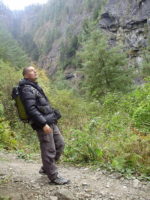 The down jacket is a brilliant invention. Very light, very compact, wildly warm. He wore it every evening starting from a height of 2000 meters. When we spent the night at the Tilicho base camp (4134 meters), where there were no extra blankets, I climbed into the sleeping bag right in the down jacket. I strongly advise you to buy a light tourist down jacket, and not take a ski jacket instead. It weighs more, and heats much worse.My blue anorak windbreaker also did a great job. On the track I wore it almost every day. It “breathes” very well, a million times better than any membrane. At the same time, it is absolutely not blown by the wind.I wore a membrane jacket only once – near Jomsom, when it rained all day. The umbrella perfectly protected me from the rain and the jacket turned out to be reinsurance. In conditions where every evening a dry and warm overnight stay awaits you, it is not advisable to carry extra rain protection. Although a lot depends on the time of year – if you are going to Nepal closer to the rainy season, then perhaps a raincoat will make more sense.
The down jacket is a brilliant invention. Very light, very compact, wildly warm. He wore it every evening starting from a height of 2000 meters. When we spent the night at the Tilicho base camp (4134 meters), where there were no extra blankets, I climbed into the sleeping bag right in the down jacket. I strongly advise you to buy a light tourist down jacket, and not take a ski jacket instead. It weighs more, and heats much worse.My blue anorak windbreaker also did a great job. On the track I wore it almost every day. It “breathes” very well, a million times better than any membrane. At the same time, it is absolutely not blown by the wind.I wore a membrane jacket only once – near Jomsom, when it rained all day. The umbrella perfectly protected me from the rain and the jacket turned out to be reinsurance. In conditions where every evening a dry and warm overnight stay awaits you, it is not advisable to carry extra rain protection. Although a lot depends on the time of year – if you are going to Nepal closer to the rainy season, then perhaps a raincoat will make more sense.
Socks.
- thick trekking socks Lorpen- 2 pairs of 100 grams
- thin trekking socks X-socks – 35 grams
- fleece socks Ordana- 70 grams
All socks were regularly used in different combinations: only thick, thick plus thin, thin plus fleece. I didn’t rub calluses, because at the first sign of abrasions I put on sandals and let my feet “ventilate” for half a day. I sometimes slept in fleece socks (Polartec 200) – very warm and comfortable. In principle, it was possible to take one pair of socks less. I will not tire of repeating that thick trekking socks, being washed for a very long time, are reluctant to dry.
Gloves and mittens.
- fleece gloves – 85 grams
- fleece mittens – 75 grams
Gloves were used almost every evening – after a cold shower you get cold even at +10. I wore fleece mittens over gloves only when climbing 5000 meters. Maybe next time I’ll take membrane mittens instead.
Knee pads.
Weight – 130 grams. I wear knee pads all the time, even on short and easy hikes. They protect the knee joints from hypothermia (in shorts) and from overload (under a heavy backpack). In Nepal, after a whole month of walking, my knees hurt a little despite the almost constant use of knee pads. Apparently, the matter is in an overly heavy backpack (about 14 kg).It turned out to be completely impossible to use knee pads at an altitude of more than 4000 meters. There they begin to interfere with blood circulation and the legs freeze slightly or weaken.
Sunglasses.
- sport glasses Dunlop, 3rd protection category – 35 grams
- glass case and elastic – 77 grams
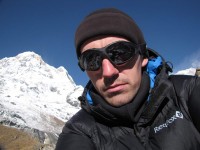 I usually don’t wear dark glasses – a wide-brimmed hat is enough to protect my eyes from the sun. In the highlands, such a number will not work. Above 3500 meters, I constantly kept a case with glasses on hand (I fastened it to the backpack from the outside) so that at any time I could hide behind the glasses from the sun or dust. And above 4000 meters, the glasses were removed only after sunset – the ultraviolet just roasted, and the snow shone like a flash. To be honest, it was a little annoying – the many hours of pressure on the head of the goggles caused noticeable discomfort. It turned out to be much more convenient to walk with an alternative mount on a wide elastic band (like a ski mask).
I usually don’t wear dark glasses – a wide-brimmed hat is enough to protect my eyes from the sun. In the highlands, such a number will not work. Above 3500 meters, I constantly kept a case with glasses on hand (I fastened it to the backpack from the outside) so that at any time I could hide behind the glasses from the sun or dust. And above 4000 meters, the glasses were removed only after sunset – the ultraviolet just roasted, and the snow shone like a flash. To be honest, it was a little annoying – the many hours of pressure on the head of the goggles caused noticeable discomfort. It turned out to be much more convenient to walk with an alternative mount on a wide elastic band (like a ski mask).
Equipment.
MEC Alpinelite 85 backpack.
Weight after lightening – 1600 grams. At the beginning of the trip, the backpack was a little more than half full, but it weighed a lot. Going to small radial exits, I always took a backpack, because of its “body kit”: mounts for GPS, camera, drinking system. Even an almost empty backpack can be pulled together with straps so that it does not hang out and sits tightly on the back. Focusing on the forecasts, I did not take a rain cover – I limited myself to packing things in garbage bags. And when it started to rain, I tried to cover the top of the backpack with an umbrella. He still got wet, but not significantly.
Hannah Scout sleeping bag.
Weight with a cover – 900 grams. The sleeping bag is very old, quite heavily compressed. But I didn’t expect miracles of thermal insulation from him – I counted on hotel blankets (on top of the sleeping bag, and not instead of it). Thus, he performed primarily a hygienic function. Although a couple of times even with a blanket it was a bit cold, and they are not provided at the Tilicho base camp at all. Therefore, for the following tracks, I purchased an Exped Starling 500 down sleeping bag. It weighs 1070 grams, is compact, has already been tested by me at -16°C< /span>.
Trekking poles.
Weight – 530 grams. When hiking, I always walk with sticks, even on flat terrain. They take the load off the joints of the legs, reduce the risk of falling, just increase the power. True, in the Himalayas several times, storming a new height for me, I weakened and simply dragged the sticks behind me. But an hour later, on the descent, the hands came to life again and more than effectively worked with sticks.
Umbrella.
 Weight – 225 grams. A regular folding umbrella with three-segment spokes, which makes it very compact, but too strong. Nevertheless, he has already gone through a lot of campaigns and somehow holds on. The main disadvantages are a short handle and difficulties when trying to fold / unfold in the wind (due to the three-segment). There are also advantages – unlike raincoats, it does not soar, it is brought into combat readiness much faster, it protects more reliably from rain. I have long dreamed of buying a Golite Chrome Dome umbrella with solid spokes and a silver dome that reflects the sun’s rays.
Weight – 225 grams. A regular folding umbrella with three-segment spokes, which makes it very compact, but too strong. Nevertheless, he has already gone through a lot of campaigns and somehow holds on. The main disadvantages are a short handle and difficulties when trying to fold / unfold in the wind (due to the three-segment). There are also advantages – unlike raincoats, it does not soar, it is brought into combat readiness much faster, it protects more reliably from rain. I have long dreamed of buying a Golite Chrome Dome umbrella with solid spokes and a silver dome that reflects the sun’s rays.
Electronics.
GPS navigator.
- GPS Garmin 60CSx – 210 grams
- fastening on a backpack strap – 15 grams
I loaded into GPS all the maps of Nepal that I found on the net, but I actually used two: Kathmandu Map and GPS map of Annapurna and Everest trekking routes. The navigator helped a lot in cities – for example, to find your hotel. It is difficult to get lost on the route, but the GPS was still useful – it suggested how much more to go to the goal. In conditions where every step is difficult, this is a significant help. The battery charge was enough for 2-3 days of continuous operation.
Photographic equipment.
- camera Canon SX10 IS – 560 grams
- photo case LowePro Apex 110 AW – 300 grams
- photo tripod Arsenal-1120 – 463 grams
- batteries AA – 20 pieces 700 grams
- Charger Sony for acc. AA and AAA – 195 grams
- memory cards SD 16Gb+16Gb+8Gb
- external hard drive Transcend StoreJet 25 (500 gigabytes) – 205 grams
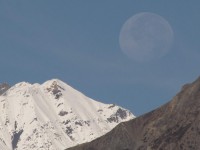 I was very pleased with the 20-fold megazoom – the tops of the mountains could only be reached by it. This zoom can be used like binoculars. The camera worked like hell – I took from 300 to 500 pictures a day. As a result, I “clicked” 38 gigabytes – all the available SD memory. But the external hard drive didn’t get anything – I won’t take it anymore. The tripod never got out – there was no time. Next time I’ll take a very tiny 50-gram tripod. You can also take fewer batteries – I managed to recharge more than once a week, as I planned, but twice as often. True, AA was not only for my camera, but also for GPS and for a flashlight. The charger worked stably despite the extremely low voltage in rural hotels. One problem – the plug did not hold well in the wide Nepalese sockets – it is desirable to have an adapter. I wore a case for the camera on the belt of my backpack, and fastened the shoulder strap only during the evening radials and then in the capital.
I was very pleased with the 20-fold megazoom – the tops of the mountains could only be reached by it. This zoom can be used like binoculars. The camera worked like hell – I took from 300 to 500 pictures a day. As a result, I “clicked” 38 gigabytes – all the available SD memory. But the external hard drive didn’t get anything – I won’t take it anymore. The tripod never got out – there was no time. Next time I’ll take a very tiny 50-gram tripod. You can also take fewer batteries – I managed to recharge more than once a week, as I planned, but twice as often. True, AA was not only for my camera, but also for GPS and for a flashlight. The charger worked stably despite the extremely low voltage in rural hotels. One problem – the plug did not hold well in the wide Nepalese sockets – it is desirable to have an adapter. I wore a case for the camera on the belt of my backpack, and fastened the shoulder strap only during the evening radials and then in the capital.
MP3 player
- mp3 player Iriver T60 (4 gigabytes) – 50 grams
- batteries AAA – 8 pieces 100 grams
- USB cable – 40 grams
- card reader – 50 grams
The player helps a lot on long trips. Especially at a height where it is impossible to talk with comrades on the go. In a month I listened to 10 gigabytes of audiobooks and some music. He turned on the music when he needed to cheer up – on long climbs, in early exits, etc. For a whole day of playback, the player “ate” from 1 to 2 AAA batteries. Using a USB cable and a card reader, I updated the contents of the player several times – I kept “spare” audiobooks on temporarily empty cards for the camera.
Mobile phone.
- mobile Nokia – 95 grams
- Nokia charger – 40 grams
The coverage was 60% of the track. But before the trip, we did not have enough time to buy a local SIM card. Therefore, the phone worked only in alarm mode. But every day – got up early (5:30). And home called from hotels.
Lanterns.
- Petzl Zipka flashlight – 68 grams (with batteries)
- Petzl Myo XP Belt Flashlight – 140 grams (without batteries)
My wife and I used these two flashlights, Taras had his own. Flashlights are always needed. Firstly, electricity is cut off regularly in Nepal. Even in the capital, every evening from 6 to 8 only shops and expensive hotels with generators light up. On the track, some simple lodges only light up the dining room, and the lights in the rooms do not light up. In addition, a couple of times we started in the dark. For example, we left the base camp of Annapurna at 3 am, and there was dense fog. The powerful beam of light emitted by Petzl Myo helped to find the way in such conditions.
Stuff.
Food shop.
- metal thermos 1 liter – 590 grams
- Deuter Source hydrator 2 liters – 150 grams
- Swiss knifeth – 83 grams
- tablespoon – 25 grams
In a thermos we brewed tea 3-4 times a day: for lunch, dinner and breakfast. It is much cheaper than buying tea in glasses. And during the day, not halts in the highlands, hot drinks help to warm up. I drank from a hydrator during the day on the track (below the snow zone). I did not carry other containers (bottles). Swiss army knife-scissors-tweezers-toothpick-screwdriver-can opener was always at hand. But it is not necessary to take a spoon.
Hygiene.
- towelse – 100 grams
- toothbrush – 10 grams
- toothpaste – 50 grams
- soap – 60 grams
- toilet paper – 80 grams
A towel (40×40 centimeters) made of microfiber absorbs more efficiently than usual. But it doesn’t dry fast enough. I’ll have to look for a thinner microfiber. I washed with soap, washed and shampooed. The consumption of toilet paper increased sharply with the onset of a cold, I had to buy a roll every 3 days.
Misc.
- banana wallet Moneybelt – 40 grams
- wristwatch – 50 grams
- liquid compass – 51 grams
- Rogue cartridge – 20 grams
- self-tapping hooks – 3pcs 11 grams
- linen cord – 8 meters 60 grams
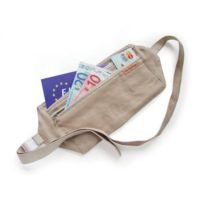 Flesh-colored banana purse designed to be discreetly worn under clothing. During the trip, I didn’t wear it (it interferes), but in Kathmandu and the reserve I dragged it all the time. I did not want to leave money and a passport in the room.The tablet compass is a clear overkill, you need to look for something easier. And the clock … they are clocks in Africa.The “rogue” cartridge was supposed to produce electricity in those hotels where there are no outlets, but there is a light bulb. However, it turned out that Nepalese bulbs have a completely different, non-threaded base.It is not necessary to drag self-tapping screws – the clothesline can almost always be pulled without them. We dried all the time – towels, washed linen and laundered bucks)))
Flesh-colored banana purse designed to be discreetly worn under clothing. During the trip, I didn’t wear it (it interferes), but in Kathmandu and the reserve I dragged it all the time. I did not want to leave money and a passport in the room.The tablet compass is a clear overkill, you need to look for something easier. And the clock … they are clocks in Africa.The “rogue” cartridge was supposed to produce electricity in those hotels where there are no outlets, but there is a light bulb. However, it turned out that Nepalese bulbs have a completely different, non-threaded base.It is not necessary to drag self-tapping screws – the clothesline can almost always be pulled without them. We dried all the time – towels, washed linen and laundered bucks)))
Summary
I calculated the weight of the “red” lines of this list and it turned out to be only 1600 grams. Plus, not allocated, but mentioned extra socks, batteries, compass, photo belt and other small things – another 300 grams. A half-empty backpack can be safely changed to a lighter one – 900 grams Golite Pinnacle. Lighter fleece and thermal underwear could save 250-300 grams. So, step by step, you can slowly “lighten” up to 10 kilograms, at least a third of which will be constantly dressed on me. Or you, if you decide to take advantage of my experience, going on a hike in Nepal.Go to the table of contents of the trekking report in Nepal.P.S. In October 2010, I will fly to Nepal again – I will lead a group to Annapurna Base Camp. For the participants of this hike, I am writing another article with recommendations for choosing equipment for Nepal.
